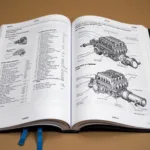Remote control (RC) toy cars can provide hours of entertainment, but like any electronic device, they can malfunction. Instead of tossing a broken toy, why not try to repair it? This comprehensive guide will cover common RC toy car problems and provide step-by-step instructions on how to fix them.
Identifying the Problem: Where to Start
Before diving into repairs, it’s crucial to pinpoint the issue. Is the car not responding to the remote control? Is it moving erratically or slowly? Or is the problem with the remote control itself? Here’s a breakdown of common RC car issues and potential causes:
1. Car Doesn’t Respond to the Remote:
- Dead batteries: This is the most common culprit. Check and replace batteries in both the car and the remote.
- Loose wiring: Inspect the wiring connections in the car and remote for any loose or disconnected wires.
- Faulty antenna: A damaged or loose antenna can disrupt signal transmission. Check for any visible damage.
- Malfunctioning receiver: The receiver inside the car might be faulty, preventing it from receiving signals from the remote.
2. Erratic or Slow Movement:
- Low batteries: Weak batteries can cause sluggish performance.
- Gear issues: Stripped gears or misaligned gears can hinder movement.
- Motor problems: A worn-out or jammed motor can lead to slow or inconsistent speed.
3. Remote Control Issues:
- Dead batteries: Always rule this out first by replacing the batteries in the remote.
- Damaged buttons: Check if any buttons are stuck or unresponsive.
- Faulty transmitter: The transmitter inside the remote might be malfunctioning, preventing it from sending signals.
Essential Tools for RC Car Repair
Having the right tools is crucial for a successful repair. Gather the following:
- Small Screwdriver Set: Essential for opening the car and remote casings.
- Soldering Iron and Solder: For repairing or replacing wiring and electronic components.
- Multimeter: Helps test batteries, motors, and other electrical components.
- Wire Cutters and Strippers: For working with wires.
- Electrical Tape: For insulating and securing wire connections.
- Replacement Parts: Depending on the issue, you might need new batteries, gears, motors, or other components.
Step-by-Step Repair Guide
Once you’ve identified the problem and gathered your tools, follow these general repair steps:
-
Power Down: Always disconnect the batteries from both the car and the remote control before starting any repairs.
-
Open the Casings: Carefully open the car and remote control casings using the appropriate screwdriver.
-
Inspect the Wiring: Examine all wiring connections for any loose or disconnected wires. Re-solder any broken connections.
-
Test the Batteries and Motor: Use the multimeter to check the battery voltage in both the car and the remote. Test the motor for functionality.
-
Check the Gears: If you suspect gear problems, inspect the gears for any stripping or misalignment. Replace or realign as needed.
-
Examine the Antenna: Ensure the antenna on the car and remote are securely attached and free of damage.
-
Test the Remote Control: If the remote control is the issue, check the buttons and replace them if necessary.
-
Consider Replacement Parts: For faulty receivers, transmitters, or other electronic components, consider ordering replacement parts.
Seeking Expert Help
While this guide provides general repair instructions, some issues might require specialized knowledge or tools. Don’t hesitate to contact a professional RC car repair shop or consult online forums for further assistance.
Conclusion
Repairing a remote control toy car can be a rewarding experience. By following this guide and exercising patience, you can often breathe new life into your child’s favorite toy and avoid the need for a replacement. Remember to prioritize safety and always disconnect the power before beginning any repairs.

